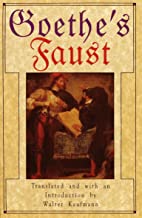Faust Part Two is the second part of Goethe’s Faust. It was published in 1832, the year of Johann Wolfgang von Goethe’s death.
Johann Wolfgang von Goethe’s Faust was published in two parts: Faust Part One and Faust Part Two.
Goethe finished writing Faust Part Two in 1832, the year of his death. In contrast to Faust Part One, the focus here is no longer on the soul of Faust, which has been sold to the devil, but rather on social phenomena such as psychology, history and politics. The second part formed the principal occupation of Goethe’s last years and appeared only after he died.
Synopsis
[From Wikipedia ~2009]
Part Two
Rich in classical allusion, in Faust Part Two, the romantic story of the first Faust is forgotten, and Faust wakes in a field of fairies to initiate a new cycle of adventures and purpose. (The piece consists of five acts – relatively isolated episodes – each representing a different theme).
Act I
The first sees Mephistopheles saving the imperial finances of German emperor Charles V – and so the German empire – by introducing the use of paper money. Amidst the ensuing celebrations, Faust enters the “realm of the mothers” – variously described as the depths of the psyche or the womb – in order to bring back the “ideal form” of beauty for the Emperor’s delight. In this case, that ideal form is Helen of Troy. Faust falls in love with Helen.
Act II
An artificial person made by an alchemical process, the Homunculus, leads Faust and Mephistopheles to the “Classical Walpurgisnacht“, where they encounter Gods from Greek antiquity.
“Some of these Gnostics seem to have accepted Simon Magus as the ‘Power of God’—as the Logos, or divine Reason, by which the world was created (or reduced from chaos to an ordered Cosmos). From this a curious myth arose. This Logos, or creative Power, was identified with the Sun-god, as the source of life, and as Sun-god was united to the Moon-goddess, Selene. Now the words Helen and Selene are connected in Greek, and Helen of Troy was accepted by these Gnostics as a mythical form of the goddess of the moon. Hence it came that in the Gnostic form of the Simon Magus legend he was married to Helen of Troy, and this notion found its way into the old Faust-legend, and is used by Goethe in that exceedingly wonderful and beautiful part of his great poem which is called the Helena.”
The Project Gutenberg eBook of The Faust-Legend and Goethe’s ‘Faust’ [para 24], (2004). H. B. Cotterill (1912)
Act III
The third act describes Faust’s relationship with Helen, with whom he has a son, Euphorion. His son falls to his death at the end of the act, whereupon Helen also disappears.
Act IV
In the fourth act, Faust returns to the emperor, who is at war with the Gegenkaiser. With the help of Mephistopheles’ ordered ranks of Daemons they achieve victory.
Act V
Faust has nothing left but to tame nature itself. Upon disclosing his plans, Faust recognises the moment of sheer bliss which he would seek to prolong and drops dead. As a result, he loses his wager with Mephistopheles, who tries to claim his soul.
However, as Goethe expresses in the final scene, Mephistopheles’ handling of Faust permitted the latter to strive for something essentially positive and thus his soul could be saved. “Whoever strives in ceaseless toil, Him we may grant redemption”. Thus as Mephistopheles gloats, angels descend and retrieve the immortal part of Faust’s soul, providing redemption and ascension to the higher realm.
Analysis and influence
The story of Faust inspired a great deal of literature, music and illustration and countless interpretations have been made of Faust, Part Two. (Jungian, Freudian, sociological, alchemical, literary and classical to name but a few).
Although today many of the classical and Central European themes may be hard for the modern reader to grasp, the work can still be considered as pertinent in the field of science and scientific understanding. In heavily poetic terms, Goethe offers an involved, holistic approach to these areas of study quite different from our own view of science as a wholly analytic field but, nevertheless, very much in tune with some modern thinking.
Relationship between the parts
Throughout Part One, Faust remains unsatisfied; the ultimate conclusion of the tragedy and the outcome of the wagers are only revealed in Faust Part Two. The first part represents the “small world” and takes place in the commoners’ milieu, and presents a criticism of society. In contrast, Part Two takes place in the “wide world” or macrocosmos of politics and industrialism, and criticizes politics and the greed of the early industrialists. This play is composed of fragments, written by Goethe over a long period of time.
References
Much of the content of this article is translated from the equivalent German-language wikipedia article (retrieved November 6, 2005). The German articles Johann Wolfgang von Goethe, Gustaf Gründgens, and Knittelvers were also referred to. The following references are cited by the German-language Faust I:
- H. Arens Kommentar zu Goethes Faust I. Heidelberg 1982, Carl Winter Universitätsverlag, ISBN 3-533-03184-5
- A. Schöne Faust. Kommentare. Enthalten in: Goethe Faust. Frankfurt am Main 1994, Deutscher Klassiker Verlag, ISBN 3-618-60270-7
- U. Gaier Faust-Dichtungen. Kommentar I. Enthalten in: Johann Wolfgang Goethe Faust-Dichtungen. Stuttgart 1999, Philipp Reclam jun. Verlag, ISBN 3-15-030019-3
- Gero von Wilpert: Goethe encyclopedia, Stuttgart, Kroener 1998, ISBN 3-520-40701-9
- Gerhard Kaiser, Ist der Mensch zu retten? Vision und Kritik der Moderne in Goethes Faust, Rombach Wissenschaft, ISBN 3-7930-9113-9 (German)
External links
- Translation of Parts 1 and 2 of Faust by A. S. Kline: http://www.poetryintranslation.com/PITBR/German/Fausthome.htm
- Translation of Parts 1 and 2 and a scene-by-scene study of Faust by A. S. Kline: http://www.poetryintranslation.com/PITBR/German/TheRestlessSpiritweb.htm

This article is licensed under the GNU Free Documentation License. It uses material from the Wikipedia article “Faust, Part Two“.

